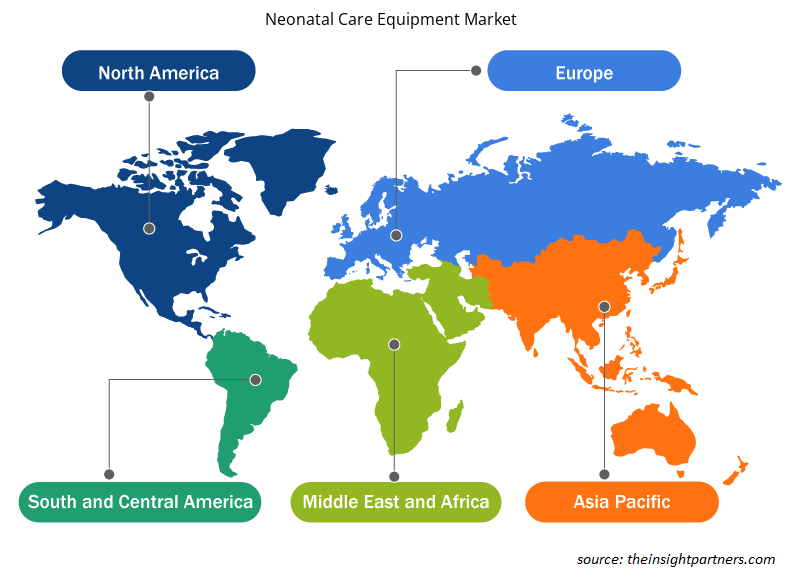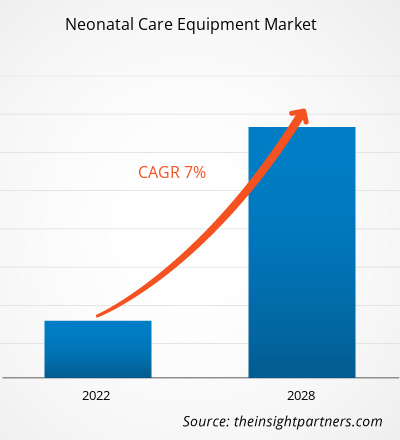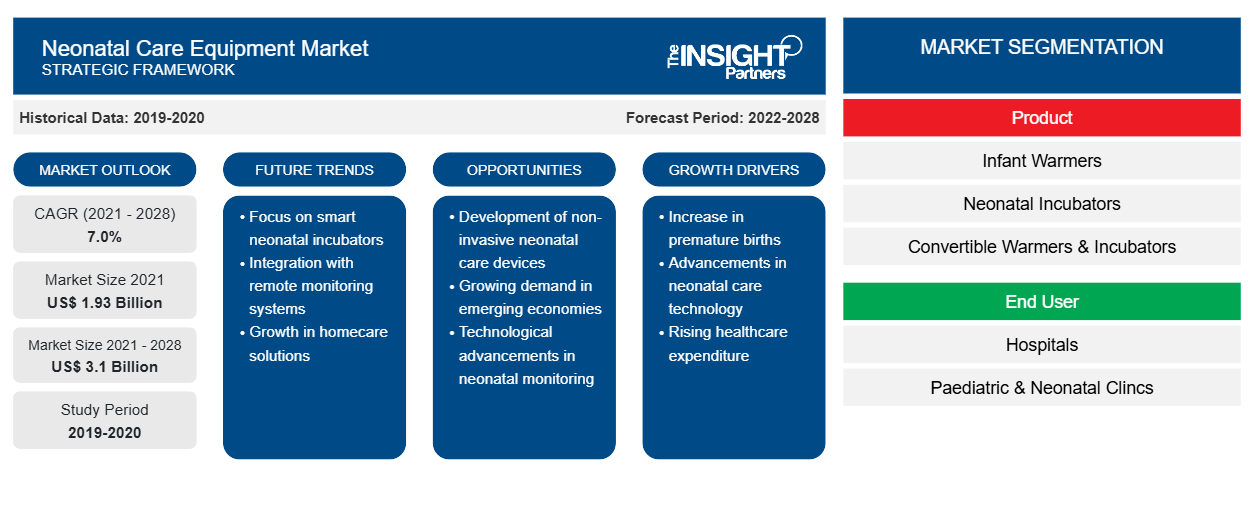新生儿护理设备市场规模预计将从 2021 年的 19.3424 亿美元增至 2028 年的 31.0381 亿美元。预计 2022 年至 2028 年的复合年增长率为 7.0%。
新生儿护理设备用于护理体弱多病的新生儿,使其保持温暖、跟踪其生长情况、治疗黄疸并提供氧气或呼吸支持。使用各种设备来照顾婴儿,例如电暖器、新生儿呼吸机、持续气道正压通气装置、血压监测仪、心脏监测仪、脉搏血氧仪、二氧化碳分析仪、综合监测设备和其他设备。
该报告对全球新生儿护理设备市场进行了深入分析,重点介绍了市场趋势、技术进步和市场动态等各种参数。它还提供了主要市场参与者的竞争格局分析以及 COVID-19 疫情对所有主要地区市场的影响。
定制此报告以满足您的需求
您可以免费定制任何报告,包括本报告的部分内容、国家级分析、Excel 数据包,以及为初创企业和大学提供优惠和折扣
-
获取此报告的关键市场趋势。这个免费样品将包括数据分析,从市场趋势到估计和预测。
北美的整体医疗成本正在大幅上涨。2020 年,美国医疗系统的直接成本为 53 亿美元。2020 年,医疗保健系统为该国年度总成本额外贡献了 600 亿美元。2020 年,北美超过 40% 的人口取消了预约,13% 的人报告说他们需要护理但没有安排或接受护理。COVID-19 大流行改变了北美国家的经济状况和社会行为。政府为减轻疾病传播而采取的遏制措施改变了美国的医疗服务提供模式。根据急诊医学部的数据,在全国许多城市,2020 年急诊室 (ED) 就诊人数减少了约 40%。此外,门诊预约和选择性治疗被推迟或由远程医疗取代。
2021 年 11 月,辉瑞公司宣布了正在研究的 COVID-19 口服抗病毒候选药物 PAXLOVID。根据对高危患者中蛋白酶抑制 COVID-19 的 2/3 期评估 (EPIC-HR) 的中期分析,这是一项针对未住院且有发展为重症高风险的成年 COVID-19 患者的随机双盲研究,据报道,PAXLOVID 疫苗减少了住院和死亡人数。2021 年头几个月疫苗生产存在供应限制。然而,建立新工厂和促进技术变革是支持美国和加拿大加强剂量生产及其管理计划的策略。
患有疾病且需要长期住院的早产儿和足月儿容易发生医院内感染,因此,在 COVID-19 疫情爆发后,婴儿护理机构采用新生儿护理设备受到了不利影响。因此,北美大众的金融危机预计将阻碍新生儿护理设备市场的增长
根据地区,全球新生儿护理设备市场分为北美、欧洲、亚太、中东和非洲、南美和中美。
市场洞察
早产和低体重出生婴儿数量的增加推动了全球新生儿护理设备市场的发展
早产和低体重出生率的增加是推动胎儿和新生儿护理设备市场增长的主要因素之一。随着出生数量的增加,许多并发症与早产有关,导致新生儿死亡。早产被定义为妊娠37周前的活产,出生体重低于2500克被认为是低体重出生。根据2020年7月发表在《国际妇产科杂志》上的一项名为《早产的全球负担》的研究,全球约有1500万婴儿早产,全球早产 率约为11%。此外,在美国,根据美国疾病控制和预防中心2021年11月更新的一篇题为《早产》的文章报道,2020年出生的每10个孩子中就有一个是早产的。此外,新生儿的发病率也有所增加。这些因素增加了新生儿护理设备市场对胎儿和新生儿护理设备的需求。
早产仍然是一个重大的公共卫生问题,占全球新生儿死亡率的 75%。当无法准确确定胎龄时,低出生体重 (LBW) 是早产的重要但不完美的替代指标。虽然早产和 LBW 新生儿之间存在重叠,但早产和 LBW 兼具的新生儿发生不良结局的风险最高。世界卫生组织 (WHO) 估计,每年有超过 1500 万婴儿早产,约 100 万婴儿死于早产问题。根据世界卫生组织的数据,超过 60% 的早产发生在南亚和非洲。低收入国家的早产率约为 12%,而高收入国家的早产率约为 9%。2018 年,印度记录了约 3,519,100 例早产。早产儿体温过低的患病率不断上升是一个重大的公共卫生问题。世界卫生组织报告称,早产是新生儿死亡和发病的主要原因。早产的常见原因是感染、高血压和糖尿病等慢性疾病以及多胎妊娠;然而,通常无法查明原因。因此,早产数量的增加和生存担忧的增加刺激了对新生儿护理设备的需求,以管理与早产相关的并发症。
基于产品的见解
根据产品,全球新生儿护理设备市场细分为婴儿保暖器、新生儿孵化器、可转换保暖器和孵化器、新生儿光疗设备、呼吸护理设备、新生儿监测设备、新生儿诊断成像设备和其他护理设备。2021 年,新生儿呼吸护理设备细分市场占据了新生儿护理设备市场的最大份额。该细分市场的市场地位归因于新生儿呼吸窘迫综合征病例的增加。
新生儿护理设备市场区域洞察
Insight Partners 的分析师已详尽解释了预测期内影响新生儿护理设备市场的区域趋势和因素。本节还讨论了北美、欧洲、亚太地区、中东和非洲以及南美和中美洲的新生儿护理设备市场细分和地理位置。

- 获取新生儿护理设备市场的区域特定数据
新生儿护理设备市场报告范围
| 报告属性 | 细节 |
|---|---|
| 2021 年市场规模 | 19.3亿美元 |
| 2028 年市场规模 | 31亿美元 |
| 全球复合年增长率(2021 - 2028) | 7.0% |
| 史料 | 2019-2020 |
| 预测期 | 2022-2028 |
| 涵盖的领域 |
按产品
|
| 覆盖地区和国家 |
北美
|
| 市场领导者和主要公司简介 |
|
新生儿护理设备市场参与者密度:了解其对业务动态的影响
新生儿护理设备市场正在快速增长,这得益于终端用户需求的不断增长,而这些需求又源于消费者偏好的不断变化、技术进步以及对产品优势的认识不断提高等因素。随着需求的增加,企业正在扩大其产品范围,进行创新以满足消费者的需求,并利用新兴趋势,从而进一步推动市场增长。
市场参与者密度是指在特定市场或行业内运营的企业或公司的分布情况。它表明在给定市场空间中,相对于其规模或总市场价值,有多少竞争对手(市场参与者)存在。
在新生儿护理设备市场运营的主要公司有:
- 通用电气医疗
- 荷兰皇家飞利浦公司
- 美敦力
- 德尔格股份公司
- 日本光电公司
免责声明:上面列出的公司没有按照任何特定顺序排列。

- 了解新生儿护理设备市场顶级关键参与者概况
基于最终用户的洞察
根据最终用户,全球新生儿护理设备市场分为医院、儿科和新生儿诊所以及疗养院。医院部门在 2021 年占据最大的市场份额。
全球新生儿护理设备市场的参与者采用产品发布和扩张等有机策略,以扩大其全球影响力和产品组合。
按地域划分,北美进一步细分为美国、加拿大和墨西哥。欧洲分为法国、德国、意大利、英国、西班牙和欧洲其他地区。亚太地区分为中国、印度、韩国、日本、澳大利亚和亚太地区其他地区。中东和非洲分为南非、沙特阿拉伯、阿联酋和中东和非洲其他地区。南美洲和中美洲分为巴西、阿根廷和南美其他地区。
新生儿护理设备市场的主要参与者包括 GE Healthcare、Koninklijke Philips NV、Medtronic、Dragerwerk AG & Co. KGaA、Nihon Kohden Corporation、Natus Medical Incorporated、Fisher & Paykel Healthcare Limited、Massimo、BD 和 Novos。
- 历史分析(2 年)、基准年、预测(7 年)及复合年增长率
- PEST和SWOT分析
- 市场规模、价值/数量 - 全球、区域、国家
- 行业和竞争格局
- Excel 数据集
近期报告
客户评价
购买理由
- 明智的决策
- 了解市场动态
- 竞争分析
- 客户洞察
- 市场预测
- 风险规避
- 战略规划
- 投资论证
- 识别新兴市场
- 优化营销策略
- 提升运营效率
- 顺应监管趋势























 获取免费样品 - 新生儿护理设备市场
获取免费样品 - 新生儿护理设备市场